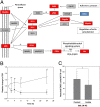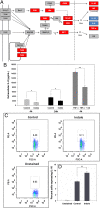The bacterial signal indole increases epithelial-cell tight-junction resistance and attenuates indicators of inflammation
- PMID: 19966295
- PMCID: PMC2806735
- DOI: 10.1073/pnas.0906112107
The bacterial signal indole increases epithelial-cell tight-junction resistance and attenuates indicators of inflammation
Abstract
Interkingdom signaling is established in the gastrointestinal tract in that human hormones trigger responses in bacteria; here, we show that the corollary is true, that a specific bacterial signal, indole, is recognized as a beneficial signal in intestinal epithelial cells. Our prior work has shown that indole, secreted by commensal Escherichia coli and detected in human feces, reduces pathogenic E. coli chemotaxis, motility, and attachment to epithelial cells. However, the effect of indole on intestinal epithelial cells is not known. Because intestinal epithelial cells are likely to be exposed continuously to indole, we hypothesized that indole may be beneficial for these cells, and investigated changes in gene expression with the human enterocyte cell line HCT-8 upon exposure to indole. Exposure to physiologically relevant amounts of indole increased expression of genes involved in strengthening the mucosal barrier and mucin production, which were consistent with an increase in the transepithelial resistance of HCT-8 cells. Indole also decreased TNF-alpha-mediated activation of NF-kappaB, expression of the proinflammatory chemokine IL-8, and the attachment of pathogenic E. coli to HCT-8 cells, as well as increased expression of the antiinflammatory cytokine IL-10. The changes in transepithelial resistance and NF-kappaB activation were specific to indole: other indole-like molecules did not elicit a similar response. Our results are similar to those observed with probiotic strains and suggest that indole could be important in the intestinal epithelial cells response to gastrointestinal tract pathogens.
Conflict of interest statement
The authors declare no conflict of interest.
Figures




Similar articles
-
The protective effect of lithocholic acid on the intestinal epithelial barrier is mediated by the vitamin D receptor via a SIRT1/Nrf2 and NF-κB dependent mechanism in Caco-2 cells.Toxicol Lett. 2019 Nov;316:109-118. doi: 10.1016/j.toxlet.2019.08.024. Epub 2019 Aug 28. Toxicol Lett. 2019. PMID: 31472180
-
Colostrum whey down-regulates the expression of early and late inflammatory response genes induced by Escherichia coli and Salmonella enterica Typhimurium components in intestinal epithelial cells.Br J Nutr. 2015 Jan 28;113(2):200-11. doi: 10.1017/S0007114514003481. Epub 2014 Dec 4. Br J Nutr. 2015. PMID: 25471114
-
HIV-1 Tat protein alter the tight junction integrity and function of retinal pigment epithelium: an in vitro study.BMC Infect Dis. 2008 Jun 6;8:77. doi: 10.1186/1471-2334-8-77. BMC Infect Dis. 2008. PMID: 18538010 Free PMC article.
-
Development, validation and implementation of an in vitro model for the study of metabolic and immune function in normal and inflamed human colonic epithelium.Dan Med J. 2015 Jan;62(1):B4973. Dan Med J. 2015. PMID: 25557335 Review.
-
Roles of indole as an interspecies and interkingdom signaling molecule.Trends Microbiol. 2015 Nov;23(11):707-718. doi: 10.1016/j.tim.2015.08.001. Epub 2015 Oct 1. Trends Microbiol. 2015. PMID: 26439294 Review.
Cited by
-
The role of the AHR in host-pathogen interactions.Nat Rev Immunol. 2024 Oct 16. doi: 10.1038/s41577-024-01088-4. Online ahead of print. Nat Rev Immunol. 2024. PMID: 39415055 Review.
-
The gut microbiome and dietary fibres: implications in obesity, cardiometabolic diseases and cancer.Nat Rev Microbiol. 2024 Oct 10. doi: 10.1038/s41579-024-01108-z. Online ahead of print. Nat Rev Microbiol. 2024. PMID: 39390291 Review.
-
Metabolic mediators: microbial-derived metabolites as key regulators of anti-tumor immunity, immunotherapy, and chemotherapy.Front Immunol. 2024 Sep 16;15:1456030. doi: 10.3389/fimmu.2024.1456030. eCollection 2024. Front Immunol. 2024. PMID: 39351241 Free PMC article. Review.
-
Potential mechanisms of traditional Chinese medicine in the treatment of liver cirrhosis: a focus on gut microbiota.Front Microbiol. 2024 Aug 21;15:1407991. doi: 10.3389/fmicb.2024.1407991. eCollection 2024. Front Microbiol. 2024. PMID: 39234554 Free PMC article. Review.
-
Genomic characterization of prophage elements in Clostridium clostridioforme: an understudied component of the intestinal microbiome.Microbiology (Reading). 2024 Aug;170(8):001486. doi: 10.1099/mic.0.001486. Microbiology (Reading). 2024. PMID: 39132742 Free PMC article.
References
Publication types
MeSH terms
Substances
Associated data
- Actions
Grants and funding
LinkOut - more resources
Full Text Sources
Other Literature Sources

